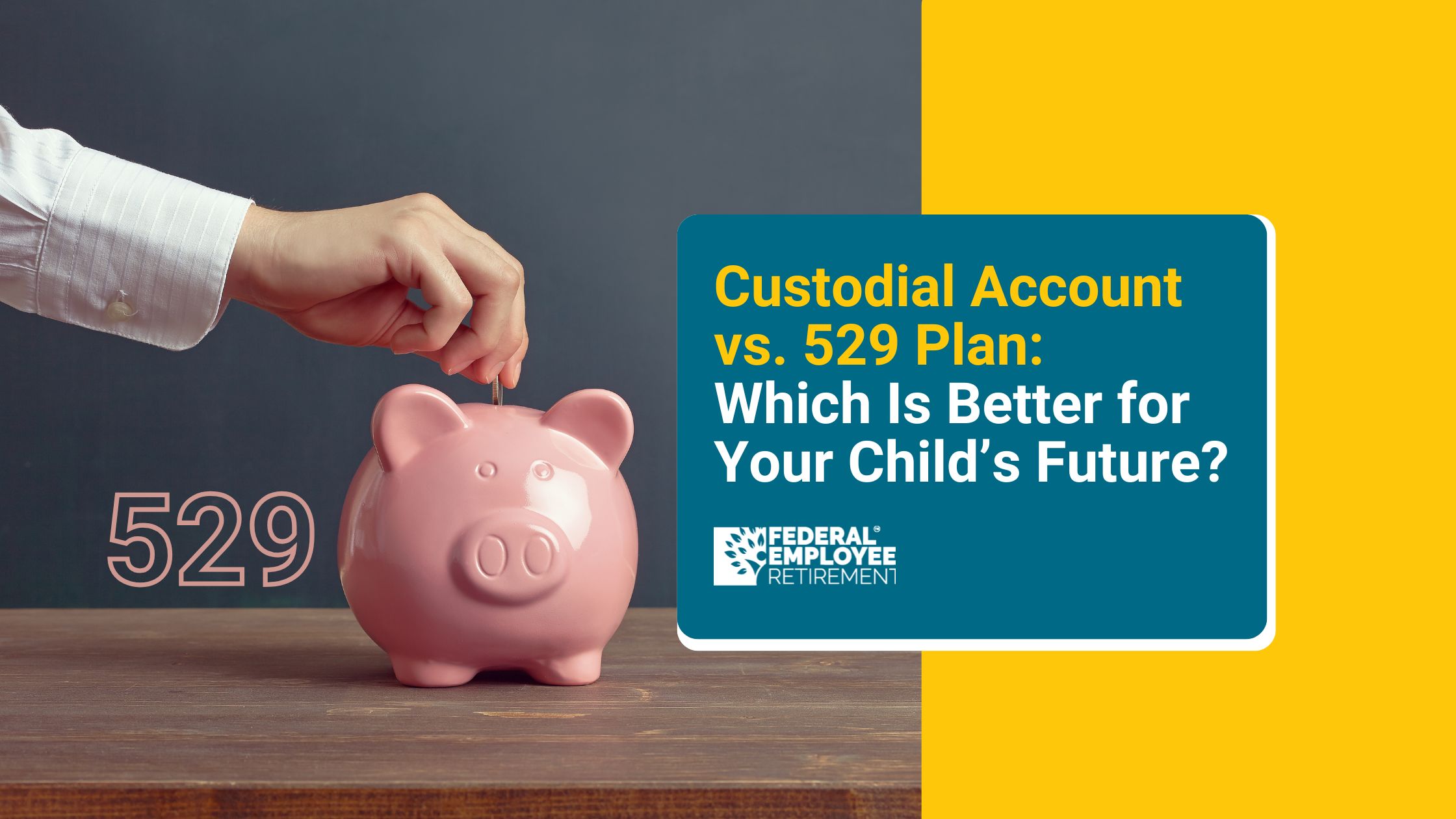You’re not alone; 4,359 federal employees booked their free review.

Custodial Account vs. 529 Plan: Which Is Better for Your Child’s Future?
Ownership is one of the most significant distinctions between a custodial account and a 529 plan.
In a custodial account, the assets legally belong to the minor, even though a parent or guardian (the custodian) manages the funds until the child reaches the age of majority usually 18 or 21, depending on the state. Once the child reaches that threshold, control of the account automatically transfers to them, and they can use the funds as they wish. Importantly, the custodian cannot reverse the gift or change the beneficiary.
In contrast, a 529 plan is owned by the account holder, not the beneficiary. Typically, the account holder is a parent or grandparent who maintains full control over how and when the money is used. Even when the child reaches adulthood, the parent can keep managing the account. If the child decides not to attend college, the funds can be transferred to another eligible family member without penalty. This retention of control is a key advantage for families who want more flexibility and oversight.
Custodial Account vs. 529 Plan: Contributions
Both custodial accounts and 529 plans allow generous contributions, but how and why you contribute and the impact of those contributions can vary greatly.
Custodial accounts don’t have specific contribution limits, but contributions are considered irrevocable gifts to the minor. This means once the money is deposited, it’s legally the child’s. While this can be a useful strategy for transferring wealth or gifting appreciated assets, it also means you’re relinquishing future control. Contributions to a custodial account count toward the federal annual gift tax exclusion $19,000 per donor in 2025 or the lifetime gift tax exemption of $13.99 million.
529 plans, on the other hand, are often used for education-specific savings goals and also don’t have official annual limits. However, each state imposes a lifetime contribution cap, often exceeding $300,000 per beneficiary. What’s more, 529 plans allow a strategy called superfunding, where you can front-load up to five years of contributions $95,000 in 2025 without incurring gift tax, as long as you make no other gifts to the beneficiary during that period. This makes 529 plans a powerful tool for long-term education funding.
Custodial Account vs. 529 Plan: Taxes
Tax treatment can significantly affect your savings growth and strategy over time.
With custodial accounts, earnings are subject to taxation under the kiddie tax rules. In 2025:
- The first $1,350 in unearned income is tax-free.
- The next $1,350 is taxed at the child’s rate.
- Any amount above $2,700 is taxed at the parent’s marginal rate.
There’s no tax benefit for contributions, and any income generated interest, dividends, or capital gains can be taxed yearly. This makes custodial accounts less tax-efficient for long-term growth unless used carefully.
By contrast, 529 plans offer considerable tax advantages. Contributions grow tax-deferred, and qualified withdrawals used for approved educational expenses are tax-free at both the federal and usually state level. Additionally, many states offer a state income tax deduction or credit for contributions. However, non-qualified withdrawals are subject to ordinary income tax on the earnings portion and a 10% penalty.
For families prioritising tax efficiency, especially for education-related expenses, 529 plans are typically the superior option.
What Is a 529 Plan?
A 529 plan is a specialised savings plan designed to encourage families to save for future education costs. Sponsored by states, agencies, or educational institutions, these plans offer tax-advantaged investment growth and flexible use for a wide range of educational expenses.
There are two types of 529 plans:
- Education Savings Plans: These operate like investment accounts. Contributions are invested in mutual funds or ETFs, and the account grows tax-free as long as funds are used for qualified educational expenses.
- Prepaid Tuition Plans: These allow families to lock in today’s tuition rates at eligible public in-state colleges and universities.
529 plans can be used for:
- College tuition and fees
- K–12 tuition (up to $10,000/year)
- Student loan repayment (up to $10,000 lifetime per beneficiary)
- Room and board
- Apprenticeship programs
Flexibility is a key advantage. If the beneficiary decides not to pursue higher education, the account owner can change the beneficiary to another qualified family member or save the funds for future educational needs.
401 a vs 403 b plan
What Is a Custodial Account?
A custodial account, created under the UGMA (Uniform Gifts to Minors Act) or UTMA (Uniform Transfers to Minors Act), allows adults to transfer financial assets to a minor. The account is legally the child’s property, but the adult custodian manages it until the child reaches the age of majority.
UGMA accounts are limited to financial assets like cash, stocks, and mutual funds, while UTMA accounts can hold a broader range of assets, including real estate and intellectual property.
The key features include:
- Wide usage flexibility: Funds can be used for anything that benefits the child, not just education.
- Investment variety: You can invest in nearly any asset type.
- Ownership transfer: Once the child comes of age, they gain full, unrestricted access to the funds.
Custodial accounts are useful for general wealth transfers and giving minors early financial ownership. However, they do come with limited control and potential tax inefficiencies, making them less appealing for those focused on structured savings.

Custodial Account vs. 529 Plan: Which One Is Right for You?
Choosing between a 529 plan and a custodial account depends on your goals, timeline, control preferences, and tax strategy.
Here’s a quick comparison to guide you:
Choose a custodial account if you want:
- Broad usage flexibility (not just education)
- To transfer ownership and responsibility at adulthood
Choose a 529 plan if you want:
- Tax-advantaged education savings
- Ongoing control of the funds
- Less impact on financial aid eligibility
For many families, the ideal approach may be to use both accounts a 529 plan for educational needs and a custodial account for general support or milestones like a first car, wedding, or business startup.
FAQ'S
What are the disadvantages of a custodial account?
- Assets belong to the child and can’t be taken back
- Reduces eligibility for financial aid
- Income may be taxed at parent’s rate (kiddie tax)
- Child gains full control at 18 or 21
- Beneficiary cannot be changed
Do parents pay taxes on custodial accounts?
Yes, if the child’s unearned income exceeds $1,300 (2025), part may be taxed at the parent’s rate.
What happens to the custodial account when a child turns 18?
The child gains full control and can use the money for any purpose, regardless of the original intent.
What is the biggest downside to a 529 plan?
- Funds must be used for education or face taxes + 10% penalty.
- Limited investment changes per year.
- Less flexibility if the child doesn’t attend college.


Get Updated
Subscribe to our weekly updates for the latest on retirement planning, federal benefits, exclusive webinars, and more!
Download Federal Retirement: Step-by-step Checklist
This comprehensive guide will help you understand your federal benefits, optimize your savings, and plan for a comfortable future.



.png)






%20VA%20%26%20Private%20Options%20Explained.jpg)

